Our study of decision markers opinions on remote working compliance is the largest in the UK, with YouGov fieldwork ending in November 2020. It produced some interesting results!
Senior managers at GB companies with remote workers believe that the effect of the coronavirus pandemic has boosted employee loyalty, as 46% say employees are less likely to leave their jobs.
"While we've found that corporate decision makers are comfortable with their staff working remotely, they're also making adjustments for improving employee support and compliance to support remote working for the long haul.
Most decision makers with remote workers at their business don't think that remote working has made staff compliance any more difficult (60%) or led to costly mistakes due to miscommunication (67%). Nevertheless, significant numbers (20%) say that their firms have implemented or are planning to implement online software to monitor remotely working employees.
1. Businesses are happy with remote-working compliance
Corporate decision makers are content with remote working and are making plans to improve compliance for remote workers. Of the decision makers that report having employees working remotely.

- Remote-working compliance isn't harder
60% of decision makers don't think that remote working has made staff compliance any more difficult. - Working from home is hugely popular
68% would like to keep on doing WFH in the future, and 70% claim that they can be as productive when WFH as in the office. - Miscommunication isn't a problem
67% of decision makers don't think that remote working is leading to costly mistakes due to miscommunication. - Many are now assessing health & wellbeing
46% of businesses have implemented, or plan to implement, assessments to monitor employee health and wellbeing. - And also online compliance records
42% of businesses have implemented, or plan to implement, online registers to record conflicts of interest and regulatory breaches. - Businesses feel employee loyalty is stronger
46% of decision makers believe that their employees have become more loyal and are less likely to leave. - The affect on bullying & harassment is unclear
33% of decision makers think that remote working has reduced the risk of bullying and sexual harassment, although an equal number don't think that it has. - Some are improving homeworking conditions, others plan for RTW
35% of businesses plan to focus on improving the workstations of remote working staff in 2021, which is only a fraction lower than the 38% who plan to focus on conversations with WFH staff about returning to the office (RTW).
2. The rise of remote-tracking of compliance
A small, but significant, section of corporate decision makers report that their business is implementing online software to track employees working remotely and monitor their productivity. Of the decision makers that report having employees working remotely:
- Larger firms are more likely to have introduced remote tracking
12% of all firms have already implemented such software (16% at larger firms). - Almost 1 in 10 firms are considering remote tracking
8% of all firms have considered it and plan to implement it in the future (11% at larger firms), while 13% have considered it but don't plan to implement it. - Nearly half of firms are yet to consider remote tracking
45% of all firms have not considered it yet.
3. Brexit won't reduce the compliance burden
We also asked our decision makers their attitude to the impending Brexit. The majority of corporate decision makers don't expect it will reduce the regulatory compliance burden.
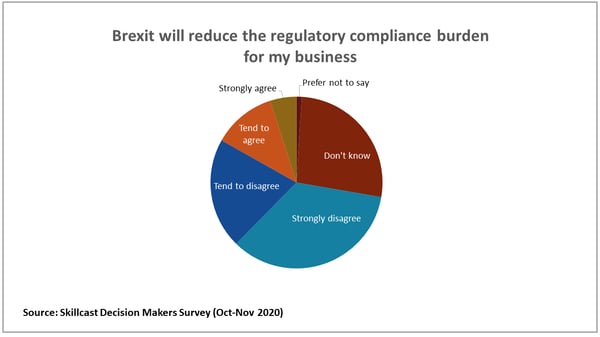
- Brexit won't reduce the compliance burden
Overall, 56% of respondents disagreed with the statement that Brexit will reduce their business's regulatory compliance burden. This view was shared fairly equally by decision makers in all job roles at firms of all sizes. - FS Legal firms feel more pessimistic about post-Brexit compliance
Decision makers at financial services firms (62%) and legal firms (72%) were more sceptical than the average about Brexit reducing the regulatory burden. - As are those in Scotland and the South of England
Decision makers at firms based in the South of England (60%) and Scotland (60%) were more sceptical than those at firms based in Wales (49%), the Midlands (50%) or London (53%).
4. Working from home risk
Basic data breach precautions aren't happening
- Password protection: 37% leave their PCs unlocked during breaks
- Privacy: 26% have no way of preventing others in their home from seeing their work or listening to their conversations
- 17% of those working from home prior to the Covid-19 outbreak
- 32% of under-35 years versus 16% of over-55 years
- Non-work devices: 16% connect personal devices to work e.g. laptop/computer
- 20% of under-35 years versus 11% of over-55 years
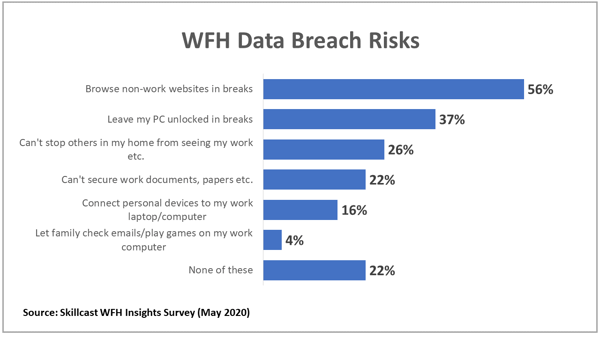
- Working from home creates health and safety concerns
Only 50% have a keyboard that is separate from their display screen (as required by HSE guidelines), only 36% work on a chair with back support, while only two thirds (68%) take regular breaks.
5. Working from home challenges
- Motivation: Staying motivated is the biggest challenge with almost half (45%) of those surveyed selecting this option.
- Staying motivated is particularly difficult for millennials (under-35's) (59%)
- Those working in Media/ marketing/ advertising/ PR & sales (56%), Finance & Accounting (51%) and Construction (51%) find staying motivated more challenging than other industry sectors
- Those with previous experience of working from home did not find staying motivated as challenging (28%) as those new to the concept (50%)
- Loneliness: Is a challenge for over a third of participants working from home (36%)
- Those working in Transportation & distribution (44%) or Medical & Health Services (43%) are more likely than other sectors to feel loneliness was a challenge
- Almost half of millennials find loneliness a challenge when working from home (44%)
- Women are more likely to find loneliness a challenge than men (40% vs 33%)
- More of the under-35's face this challenge than the over 55's (44% vs 22%)
- Distractions: A third (35%) feel that are too many distractions working at home.
-
-
- This was felt even more by those working in the Medical & health services industry (42%)
- And again, more of the under 35's face this challenge than the over 55's (41% vs 19%)
- The inability to switch off (33%) or keeping a separate work and private life (21%) were a challenge for many
- Those working in the deadline-driven Media/marketing/advertising/PR & sales industry found the inability to switch off more challenging (42%) than other sectors
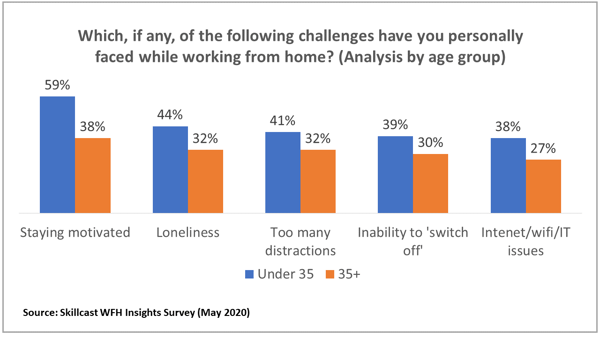
-
- Technology issues: And despite all the efforts made by employers, nearly a third (30%) continue to face challenges related to their Internet, wi-fi and other IT issues
-
-
- This figure remains nearly constant across businesses of all sizes
- Medical & Health services (22%) and IT &Telecoms (23%) sectors felt the issues less, and those in Retail (40%) and Legal (36%) slightly more
- Regionally, more employees in Wales (36%) and London (35%) are facing challenges with technology when working from home, than those in the rest of the country
- Surprisingly, fewer older workers (22% for over 55's) reported facing this challenge than younger ones (38% for under 35's), but this may be due to younger workers making more intensive use of technology
-
- Homeworkers are at Risk of Burnout: We presented 1,983 employees, confirmed as working from home all or most of the time, with a selection of patterns of taking breaks and asked them to select the one that would be typical of their working day at home during the Coronavirus outbreak.
Nearly a third (32%) reported not taking sufficient breaks, with significant numbers saying that they generally take no breaks (8%), just the lunch breaks (13%) or breaks only when the work permits (10%).
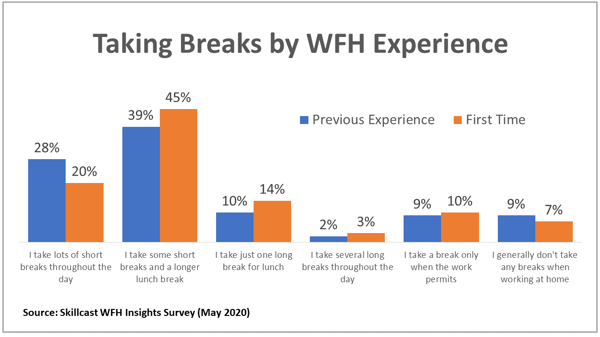
- Only 20% of those newly working from home post-Covid are taking lots of short breaks each day, and 45% are taking a lunch break plus some short breaks. A further 3% are taking several longer breaks throughout the day, bringing the total of those taking enough breaks to 68%.
- Those working from home pre-Covid fared no better with their total being 69%.
- Proportions were similar across all firm sizes, regions, gender, age and region.
- Retail sector employees working from home seem to be particularly at risk with just 57% taking enough breaks. This may simply parallel their normal working patterns – 17% say that they take a break only when the work permits, and 12% generally don't take a break at all!
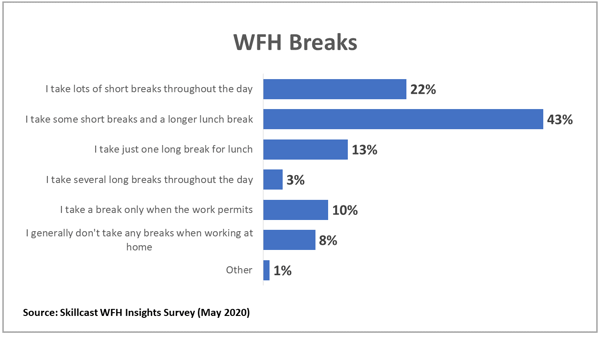
6. How Employers Can Boost Homeworking Productivity
- Productivity needs: The four top areas to increase productivity when working from home all relate to practical resources:
- Almost half (46%) require a better desk and/ or chair
- A third (32%) need a private area in their home to work in
- A quarter (26%) want better work equipment (e.g. laptop, mobile, printer)
- Over a fifth (22%) require a better/ more stable internet connection
- Communications: The two areas of improvement that are most commonly cited by HR managers and experts when discussing productivity: clearer communication of expectations by my manager (17%) and a formal working-from-home policy (12%) came in lower – perhaps because many companies are already doing well on this front.
- Meetings: Almost as many people chose fewer virtual team meetings (16%) and more virtual coffee shops/office parties (13%). That’s an interesting one for managers to act upon!
- Age: Those who had not worked from home before and millennials (under 35's) were amongst the most likely age group to need practical support. 86% of millennials selected at least one adjustment that would help them to work productively at home, compared with two-thirds (66%) of over 55's.
- IT Issues: Just 6% selected that more IT support would make them more productive, while 22% selected a better/ more stable internet connection. That matches up with the 30% of the respondents who cited Internet, Wi-Fi and IT issues as being challenges in working from home elsewhere in this survey.
- Not needing resources: As reflected amongst those who felt their productivity could be improved if they could make certain adjustments, these results seem to suggest that the older the employee is, the less likely they might be to need better resources at all.
About the YouGov fieldwork
The total sample size of this study was 2,009 corporate decision makers in Great Britain, of which 1,614 currently have employees working remotely. The fieldwork was undertaken between 27 October and 4 November 2020. The survey was conducted online. The figures have been weighted and are representative of British business sizes.
This survey was conducted using an online interview administered to members of the YouGov Plc UK panel of 800,000+ individuals who have agreed to take part in surveys. Emails are sent to panellists selected at random from the base sample. The emails invite them to take part in a survey and provide a generic survey link.
Once a panel member clicks on the link, they are sent to the survey that they are most required for, according to the sample definition and quotas (the sample definition could be "GB adult population" or a subset such as "GB adult females").
Invitations to surveys don't expire and respondents can be sent to any available survey. The responding sample is weighted to the profile of the sample definition to provide a representative reporting sample. The profile is normally derived from census data or, if not available from the census, industry-accepted data.
For full results, including breakdown by sub-groups, write to insights@skillcast.com.
Need more help with working from home compliance?
Working from home presents specific challenges to maintaining regulatory compliance. This is why your senior managers and compliance officers will need a resilient, scalable plan.
Our 3-step compliance training and assessment roadmap will help put your homeworking environment on a much stronger footing.
It includes a 10-minute training module for all staff, a 15-minute training module for managers and a self-assessment.
You can access all of these training aids for free, and they are available for roll-out as part of our Compliance Essentials Course Library.
Looking for more compliance insights?
If you'd like to stay up to date with best practices, industry insights and key trends across regulatory compliance, digital learning, EdTech, and RegTech news, subscribe to Skillcast Compliance Bulletin.
To help you navigate the compliance landscape, we have collated searchable glossaries of key terms and definitions across complex topics, including GDPR, Equality, Financial Crime and SMCR. We also track the biggest compliance fines, explaining what drives them and how to avoid them.
You can follow our ongoing YouGov research into compliance issues, attitudes and risk perceptions in the UK workplace through our Compliance Insights blogs.
We also have additional free resources such as e-learning modules, microlearning modules, and more.
If you've any questions or concerns about compliance or e-learning, please get in touch.
Written by: Vivek Dodd
Vivek Dodd MS, CFA is a Director of Skillcast. He has helped hundreds of companies to meet their mandatory compliance training requirement using e-learning courses and tools. His special interest is instructional design and the use of asynchronous learner interactions to effect behavioural change. He is a speaker on compliance training conferences, writes articles on compliance training and e-learning in various journals.



